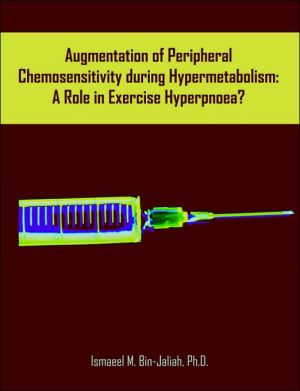

 |

|

Sold Out
Book Categories |
The carotid body initiates reflexes aimed principally at the homeostatic maintenance of blood gas tensions. This thesis tested the hypothesis that the carotid body is also a physiological glucosensor, with a role in mediating exercise hyperpnoea. In anaesthetised rats, insulin-induced hypoglycaemia (from ca. 6.5 to 2.8 mmol L-1) caused an ca. two-fold increase of oxygen consumption that was associated with a significant, carotid body-dependent increase in ventilation (from ca. 420 to 640 ml min-1 kg-1) without change in blood gas tensions. This hypoglycaemic hyperpnoea was associated with hypokalaemia and no alterations of ventilation or metabolism were observed in euglycaemic, control studies, thus excluding any role for [K+] or insulin. During hypermetabolism, a proportional augmentation of peripheral CO2 gain, measured from the phrenic electroneurogram during artificial ventilation, was shown to maintain the arterial blood gas status. In vitro, measurements of single-fibre chemoafferent discharge showed that low [glucose], over a physiological range and during normoxia, increased neither the carotid baseline discharge nor the CO2 sensitivity. Taken together, these results demonstrate that the carotid body is not a physiological sensor of glucose but augmentation of the carotid body chemosensitivity via an undetermined yet, hypermetabolism-related factor(s) is most likely to be involved in exercise hyperpnoea.
Login|Complaints|Blog|Games|Digital Media|Souls|Obituary|Contact Us|FAQ
CAN'T FIND WHAT YOU'RE LOOKING FOR? CLICK HERE!!! X
 You must be logged in to add to WishlistX
 This item is in your Wish ListX
 This item is in your CollectionAugmentation Of Peripheral Chemosensitivity During Hypermetabolism: A Role In Exercise Hyperpnoea?
X
 This Item is in Your InventoryAugmentation Of Peripheral Chemosensitivity During Hypermetabolism: A Role In Exercise Hyperpnoea?
X
 You must be logged in to review the productsX
 X
 X

Add Augmentation Of Peripheral Chemosensitivity During Hypermetabolism: A Role In Exercise Hyperpnoea?, The carotid body initiates reflexes aimed principally at the homeostatic maintenance of blood gas tensions. This thesis tested the hypothesis that the carotid body is also a physiological glucosensor, with a role in mediating exercise hyperpnoea. In anaes, Augmentation Of Peripheral Chemosensitivity During Hypermetabolism: A Role In Exercise Hyperpnoea? to the inventory that you are selling on WonderClubX
 X

Add Augmentation Of Peripheral Chemosensitivity During Hypermetabolism: A Role In Exercise Hyperpnoea?, The carotid body initiates reflexes aimed principally at the homeostatic maintenance of blood gas tensions. This thesis tested the hypothesis that the carotid body is also a physiological glucosensor, with a role in mediating exercise hyperpnoea. In anaes, Augmentation Of Peripheral Chemosensitivity During Hypermetabolism: A Role In Exercise Hyperpnoea? to your collection on WonderClub |